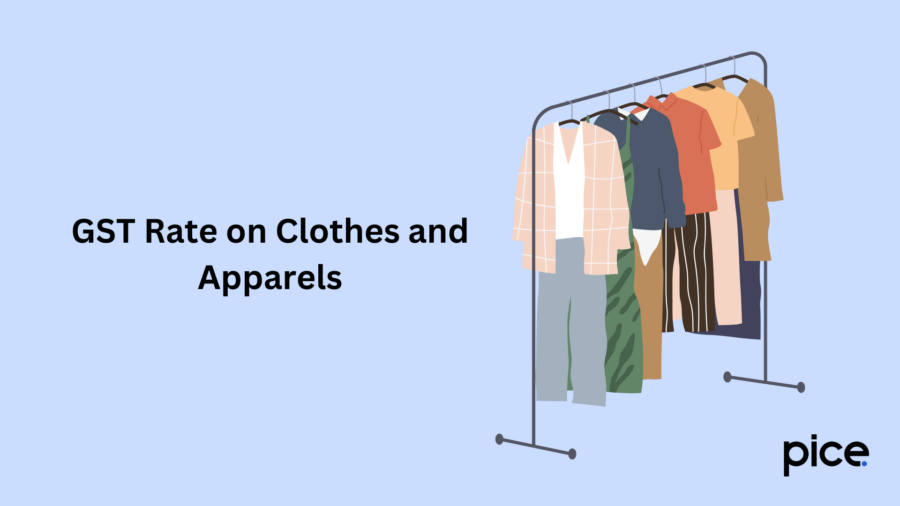GST on Clothes, Readymade Garments and Textiles
- 4 Oct 24
- 7 mins

GST on Clothes, Readymade Garments and Textiles
Key Takeaways
- Clothes priced below ₹1,000 attract 5% GST; above ₹1,000, it's 12%.
- GST impacts every stage of the textile value chain, from raw materials to finished goods.
- Small manufacturers face high costs due to the 18% GST on job work.
- AEPC proposes uniform GST rates and tax incentives to boost manufacturing and exports.
- As of 2024, GST rates remain at 5% for clothes under ₹1,000 and 12% for higher-priced items.
The implementation of Goods and Services Tax has impacted various sectors in India. One among them is the textile and apparel industry. From raw materials to finished goods, GST applies to every value addition. This has made an impact on cost dynamics for everyone: manufacturers, retailers and even consumers.
The GST rate of 12% is applicable for readymade clothes, while the 18% rate is applicable for man-made fibres. In this blog, we will further discuss the different rates of GST on clothes, GST applicability on clothing and textiles, and other related aspects.
GST Rate on Clothes and Apparels

GST rates vary depending on the type of clothing and its value. According to CBIC GST Rates, the following are the applicable rates of GST on different clothing categories and apparel:
| Sl. No. | Items | GST Rate | HSN Code | Condition |
| 1. | Apparel and clothing accessories which are neither crocheted nor knitted | 5% | 62 | Sale value less than ₹1,000 per piece |
| 2. | Clothes and apparel, or caps which are crocheted or knitted | 5% | 61 or 6501 or 6505 | Sale value less than ₹1,000 per piece |
| 3. | Handmade shawls | 5% | 6117, 6214 | Sale value less than ₹1,000 per piece |
| 4. | Other made-up textile goods | 5% | 63 (other than 6305 32 00, 6309) | Sale price less than ₹1,000 per piece |
| 5. | Worn clothing and worn articles | 5% | 6309 or 6310 | Not applicable |
| 6. | Clothing and apparel, not crocheted or knitted | 12% | 62 | Sale value of more than ₹1,000 per piece |
| 7. | Clothing and apparel, crocheted knitted | 12% | 61 | Sale value more than ₹1,000 per piece |
| 8. | Other made-up textile articles (not Worn clothing) | 12% | 63 | Sale value more than ₹1,000 per piece |
GST Rate on Textile Materials
The applicable rate of GST on textile products priced above ₹1,000 is 12%. The standard GST rate for textiles is 12%, while a reduced 5% rate applies to apparel and footwear costing less than ₹1,000.
Take a look at the table to have a better understanding of the GST rates applicable to the Indian textile sector:
| Sl. No. | Items | HSN Code | GST Rate |
| 1. | Woven fabrics of silk or silk waste | 5007 | 5% |
| 2. | Silk yarn | 5004 to 5006 | 5% |
| 3. | Garneted woolstock, shoddy wool, coarse animal hair | 5104 | 5% |
| 4. | Wool and coarse animal hair, combed | 5105 | 5% |
| 5. | Animal hair or woven fabrics of wool | 5111 to 5113 | 5% |
| 6. | Animal hair or yarn of wool | 5106 to 5110 | 5% |
| 7. | Cotton and Cotton waste | 5201 to 5203 | 5% |
| 8. | Cotton yarn (not khadi yarn) | 5205 to 5207 | 5% |
| 9. | Cotton sewing thread | 5204 | 5% |
| 10. | Woven fabrics of raw cotton | 5208 to 5212 | 5% |
| 11. | Raw, flaw or processed and not spun; flax waste and tow | 5301 | 5% |
| 12. | Woven fabrics of vegetable textile fibres, paper yarn | 5309 to 5311 | 5% |
| 13. | Woven fabrics of staple fibres (manmade) | 5512 to 5516 | 5% |
| 14. | Woven fabrics of textile materials (manmade) | 5407, 5408 | 5% |
| 15. | Ropes, jute twine, coir cordage | 5607 | 5% |
| 16. | Silver thread and zari thread (gold) | 5605, 5600, 5610 | 5% |
| 17. | Coir products | 5609 | 5% |
| 18. | Rope, twine, corrade (knotted netting) | 5608 | 5% |
| 19. | Coir mats, matting, floor covering and handloom durries | 5702, 5703, 5705 | 5% |
| 20. | Narrow fabrics which consist of warp (other than weft) gathered by Bolducs | 5806 | 5% |
| 21. | All products of knitted or crocheted fabrics | 60 | 5% |
Recent Updates of GST Regulations for the Clothing Industry in 2024

During the 2024 Interim Budget, the Apparel Export Promotion Council (AEPC) put forward the proposal of incorporating changes to the structure of GST for the textile sector. Some of these are:
The council proposed tax incentives, such as uniform GST rates and higher interest subsidies, to strengthen domestic manufacturing and enhance India’s exports.
It proposed support for marketing and branding domestic products, in terms of budget. They further requested tax concessions for manufacturers of apparel who comply with international standards of quality and with the regulations of Environmental, Social and Corporate Governance (ESG).
However, it is important to remember that these are still in the process of discussion. There have been no changes in the structure of GST for clothing so far, in 2024.
Changes in the GST Rate on Textiles
The applicable GST rate on clothes which is below the price of ₹1,000 is 5%. It was, however, proposed to increase the rate to 12% and maintain a uniform tax rate of 12%. The reason behind this proposal was to address issues due to inverted duty structures, which in turn had an impact on the textile value chain.
This adjustment in tax rate, which was effective from 2022, was in favour of simplifying the tax structure by setting a 12% GST rate on clothing, irrespective of the price. A proposal included the hike in GST rate not only on garments but also on textiles, like synthetic yarns, blankets, serviettes, etc.
It is important to remember the rate of GST is unchanged and it stands at 5% for clothes below ₹1,000. Until implementation of this proposal, the GST rate for clothing less than ₹1,000 will be 5%, and 12% for clothes more than the price of ₹1,000. The applicable rate of tax for tailoring services is 5%.
Challenges Faced by the Textile Industry
Here are some of the challenges faced by the textile industry:
- Difficulties in Filing of GST Returns: Textile manufacturers who run on a small scale usually have access to fewer resources. This not only increases the tax burden but also makes it challenging to file regular GST returns.
- High GST Rates on Job Work: The GST rate on job work remains constant at 18%, which increases job work, especially among small textile manufacturers.
- High Requirements of Working Capital: It requires high working capital for the tax on both finished goods and raw materials. This results in excessive financial strain on small manufacturers.
Conclusion
The Goods and Services Tax has led to both opportunities and challenges for the textile and clothing industry. It has eliminated the cascading effect of multiple indirect taxes and streamlined the entire process of GST compliance. By understanding the rates of GST on clothes, clothing businesses can manage their pricing strategy and consumers can better manage financial planning.
💡If you want to streamline your payment and make GST payments, consider using the PICE App. Explore the PICE App today and take your business to new heights.
 By
By 

















